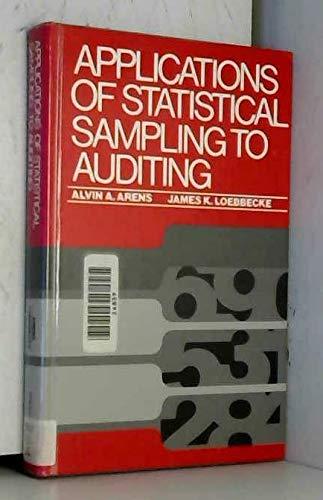In the preliminary work for a July 31, 198Y, audit, the auditor decided to test the operation
Question:
In the preliminary work for a July 31, 198Y, audit, the auditor decided to test the operation of the accounts payable/cash disbursements system. Checks written between August 1,198X, and April 30,198Y, numbered 2,731. A sample of these checks and supporting documents was examined for propriety. For each canceled check there was a voucher jacket with supporting documents included. The voucher was assigned the check number as its identification number. The check was defined as the sampling unit. The attributes to be tested were:
Receiving report included Invoice included A valid supplier Transaction consistent with firm policy Approval by authorized personnel Stamped that prices, extensions, and quantities were reviewed by the purchasing department and other items not listed for this case. Judgmentally, the auditor decided to use a sample of 80.
The client assembled the specific checks and supporting documents. Columns on a worksheet were headed for each of the items to be examined. During the examination of each check and related documents, a tick mark was placed in the column as each item of audit interest was approved. After the 80th check and supporting documents had been examined, there were still a number of positions without tick marks. Efforts to clear the open positions were successful in every respect except one: The “Invoice included” column contained four blank spaces. The related columns, “Invoice approved” and “Reviewed by purchasing department,” of course contained open spots on the same check numbers. Since there was only one basic error, invoice not attached, the auditor was in a dilemma. Did he have only one exception, or did he have four? A note in the working papers by the manager says the practice to which exceptions were taken “appearsYo be a normal practice, not an exception.”
Required :
a. Should the auditor combine all errors into one overall error rate, or should the errors in each attribute be evaluated separately?
b. Evaluate the auditor’s method of defining an error.
c. Did the auditor have one or four exceptions ?
d. How can the auditor resolve the problem that a blank in one column can automatically result in a blank in other columns?
e. What are the implications (audit and statistical) of the manager’s note in the final paragraph?
f. Is it acceptable to use statistical sampling when the auditor selects a random sample that includes only part of the year’s population?
g. A sample size of 80 items was judgmentally determined. Is that acceptable? Discuss.
Step by Step Answer:

Applications Of Statistical Sampling To Auditing
ISBN: 9780130391568
1st Edition
Authors: Alvin A. Arens, James K. Loebbecke





